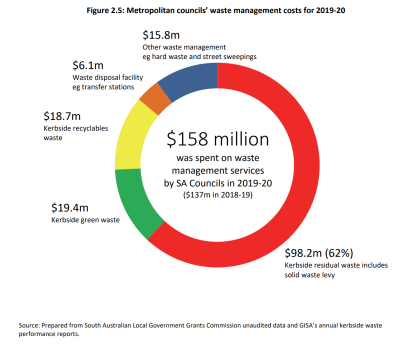
South Australia’s metropolitan council waste managements costs have risen steeply in recent years, but there’s been little change in the amount of waste ending up as landfill, an audit has found.

According to a report by the state’s auditor general, metropolitan councils spent $158 million on rubbish services in 2019-20 – $21 million more than they did the previous year.
But despite the increasing costs, there has been little change in the rate at
which metropolitan councils are diverting kerbside waste from landfill, and recent data indicates that no metropolitan council’s recovery rate has met state government diversion targets.
Potential reasons for this include:
- increases in waste levies
- increases in gate fees at resource recovery centres
- increasing fuel costs for transportation
- food waste in residual bins going to landfill
- collection mandates
- lack of community education
- increase in the number of multi unit dwellings
Judging by the two councils scrutinised by Auditor General Andrew Richardson, waste management costs also climbed for metropolitan councils during Covid 19 as more residents engaged in online shopping or set up home offices.

Turning waste into a resource
The report, released on August 17, says as well as being essential for public health and amenity, properly managed kerbside waste can become a valuable resource.
“If kerbside waste services are properly managed, waste can become a valuable resource for reuse, repurposing or recycling,” Mr Richardson says.
The report gave the councils audited a tick for their collection, transportation and processing of kerbside waste.
But it also found room for improvement, including a lack of strategic waste management plans and education programs, and better monitoring of performance against targets.
Snapshot: City of West Torrens:
West Torrens Council is located immediately west of the City of Adelaide with an estimated resident population of around 61,000, and an area of around 37 square kilometres.
In 2020‐21, West Torrens Council incurred $7.5 million in waste management costs, an increase of $800,00 from 2019-20 caused by increased waste levies and more residential waste.
“An explanation for the increase in 2019‐20 may be that more people shopped online, increasing the amount of packaging,” the report says.
“This may have been further impacted by people establishing home offices during the initial lockdown.”
The audit concluded that West Torrens Council “successfully collects, transports and processes kerbside waste to a high level of community satisfaction,” but some areas “were not operating effectively”.
These included having no stand alone waste strategy, as well as a lack of local performance targets and a formal education strategy.
The audit notes a number of Initiatives undertaken by West Torrens to minimise waste, including a weekly green waste bin collection trial and a partnership with local businesses to investigate using municipal waste to produce hydrogen from gasification.
Snapshot: NPSP Council
City of Norwood, Payneham and St Peters (NPSP Council), located east of Adelaide’s CBC with an area of around 15 square kilometres and an estimated resident population of 37,000, provides a three-bin service to some 17,500 residential households and 2,000 commercial properties.
It spent $5.7 million on waste management in 2020-21, an increase of $500,000 from the previous year, with the increase once again partly attributed to waste levies and the pandemic.
The audit found NPSP is taking initiatives to increase recycling via LGASA’s circular procurement initiative, by establishing plastic-free precincts, and by promoting product stewardship and recycling opportunities on its website.
However, like West Torrens, the audit found NPSP lacked an overarching waste management plan and education strategy, failed to document initiatives supporting its waste strategy and lacked kerbside waste performance measures and targets
Government targets
The SA government’s waste strategies set non-mandatory landfill diversion targets for metropolitan councils of 60 per cent.
South Australia’s Waste Strategy 2015–2020 set a target to reduce waste generated per capita by five per cent by 2020 from 2015 levels. In 2017‐18, waste generated per capita increased by almost nine per cent from 2015 .
While 2018‐19 saw a decrease, waste generated per capita was still 4.3 per cent higher than in 2015. In 2019‐20, waste generated per capita was 1.4 per cent lower than the baseline, but still fell short of the reduction target.
Comment below to have your say on this story.
If you have a news story or tip-off, get in touch at editorial@governmentnews.com.au.
Sign up to the Government News newsletter